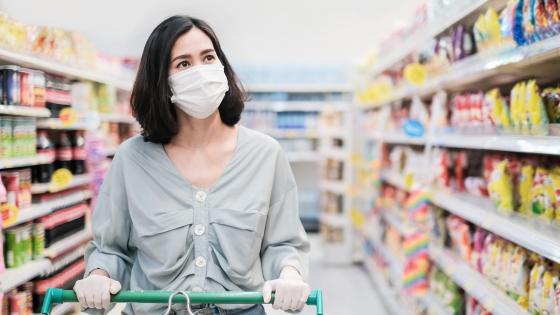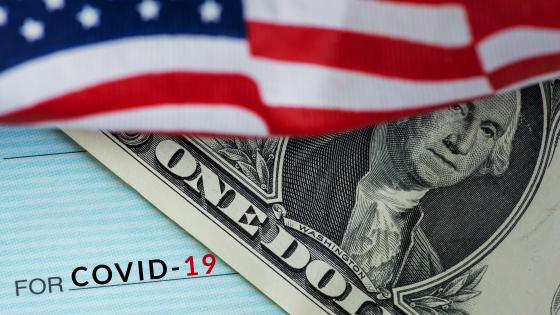In the year 2020, the COVID-19 pandemic had spread throughout the world with catastrophic economic consequences. To protect public health, many governments decided to restrict not only production, but also sales and consumption. These measures were controversial, as governments faced a trade-off between the level of economic activity and the health consequences of COVID-19 infections. A central question in the debate was how and which households would respond to the risk of infection in the absence of government intervention.
Would all households voluntarily curb their consumption to protect themselves and others, or would only the most vulnerable households reduce their consumption? Those who opposed non-pharmaceutical public health measures argued that people would protect themselves optimally against a COVID-19 infection. Therefore, government intervention would lead to an excess loss of economic activity. Those in favour of public health measures emphasised the following consumption-infection externality: consumption that involves human interaction leads to more infections, which further increases the risk of infection for everyone and thus leads to higher mortality among vulnerable strata of the population. In this case, a lack of government interventions could lead to an excess loss of economic activity and excess mortality: In the laissez-faire equilibrium, the number of infections would rise rapidly, leading to an even greater reluctance to consume, at least among the most vulnerable.
Economists have informed this debate on the basis of structural models that link consumption behaviour and infection risk in both directions in the various strata of the population. Kaplan et al. (2020) discuss in detail the pandemic possibility frontier that results. What is missing are reliable estimates of the laissez-faire consumption response of households to COVID-19 infection risk, i.e. their response in the absence of direct government restrictions (see Kay et al. 2020, for a similar identification idea on credit card data from the very first weeks of the pandemic).
In a new paper (Bachmann et al. 2024), we use novel high-quality, high-frequency, and granular German household consumption data to shed light on this issue. After Germany experienced the first wave of the COVID-19 pandemic in spring 2020, infection rates began to rise again in October 2020, after a relatively calm summer. This second wave of the COVID-19 pandemic prompted the German government to impose a second ‘lockdown’ – a non-market-based government restriction on (social) consumption activities, not a ban on free movement – on 2 November 2020, including the closure of restaurants, bars, clubs, and other recreational venues.
Our empirical strategy requires consumption data that are both comprehensive and, due to the fast-paced dynamics of pandemics, of relatively high frequency. In particular, survey (as opposed to scanner) data are uniquely suited to capture social consumption and durable goods expenditures (we define social consumption as spending on recreational activities outside the home, including sports, cultural events, restaurants, etc.) We therefore build on the Sonderbefragung zum Konsum privater Haushalte 2020 (‘Special survey on household consumption 2020’). This ad hoc survey was developed by the German Federal Statistical Office (FSO) on behalf of the German Federal Ministry of Finance and with our conceptual input, and conducted monthly from August to December 2020. In addition to sociodemographic and socioeconomic household characteristics, the survey recorded households’ expenditures across a range of broad as well as disaggregated consumption categories.
Figure 1 Engel curves of consumption expenditures over time, by infection risk
A) Total consumption
B) Social consumption
C) Durables consumption
Notes: Statistics on the cross-sectional distribution of expenditure on selected consumption categories by month and by net household income group and by infection risk. Social consumption is defined as spending on recreational activities outside the home, including sports, cultural events, restaurants, etc. Three-digit postcode areas with above (below) the median number of infections per month per 100 inhabitants are counted as high (low) risk areas. Survey weights applied.
Figure 1 displays the 25th, 50th, and 75th percentiles as well as average consumption by household net income group and month for total consumption, social consumption, and durables consumption expenditures, that is, Engel curves for the months September to November 2020. We divide households according to whether they live in a three-digit postal code with an infection risk above or below the median in that month.
Perhaps surprisingly, the Engel curves for total consumption (Panel A) are approximately constant both over time and over infection risk. If anything, there is some increase in aggregate consumption in October and November. This likely reflects aggregate stimulus measures undertaken by the German federal government at the time (see for a discussion of these measures Bachmann et al. 2021, Bachmann et al. 2022), which may have been strong enough to overcome the consumption effects of infection risk or lockdowns.
For social consumption (Panel B), we see a steady decline in spending over the three months from September to November 2020. A casual observer might interpret this decline as an indication of an effect from the increased risk of infection in October and the lockdown in November. However, the Engel curves by local infection risk, which show an almost parallel decline in consumption spending in both groups, do not permit such a conclusion. The parallel decline in consumption could be driven by seasonality, for example, worse weather conditions making social consumption less attractive. It could also be driven by aggregate developments in the risk of infection. Finally, a potential negative impact of infections risk on social consumption could be masked by a reverse causality problem if places with high social consumption experience higher infection rates. Indeed, within a month, the red lines (indicating above-median infection risk) tend to lie above the blue lines.
For durables consumption (Panel C), we see an increase in expenditures over time, in line with the findings for total consumption. However, in October (and November), unlike for total consumption, a wedge opens up between spending in high-risk and low-risk regions: average consumption is higher in low-risk regions. The comparison between median and mean consumption shows that the differences are driven by a differential decline in particularly large expenditures. At first glance, it may be surprising to find a negative effect of infection risk on durable goods expenditures, as the relative utility of durables should increase during a pandemic with more consumption at home. However, durables must first be bought, which, at least for larger and more expensive items, often requires a visual or other physical inspection of the good, or perhaps advice from sales specialists. In short, some durables require a trip to the store, which may be onerous during a pandemic.
While these changes in the Engel curves are interesting and suggestive, they cannot conclusively answer the question of how consumption behaviour responds to infection risk. We therefore turn to a regression approach, using the fact that the resurgence of COVID-19 infections in the fall of 2020 occurred in a spatially asynchronous way (see Figure 2). In particular, we exploit the spatially asynchronous unfolding of the second wave of COVID-19 between September and October 2020 to identify the effect of local infection risk on consumer behaviour. We focus on October because there was a combination of both elevated and spatially heterogeneous infection risk, but without significant government restrictions. In contrast, consumption in November would have been influenced by restrictions.
Figure 2 Infection rates across time and counties (Kreise)
Notes: Sample statistics of the cross-sectional distribution of infections relative to population across counties by month.
Source: Robert-Koch-Institut.
Combining the consumption data from the survey with these official disaggregated infection counts and spatial controls, we estimate a consumption equation with the coefficient on the number of local COVID-19 infections as our object of interest. The reference date for infections recorded by the German Robert-Koch-Institut (the German equivalent of the Centers for Disease Control and Prevention) is typically the date of a positive test.
We find that households significantly reduce their spending on social consumption and on consumer durables when local infection risks are higher. An increase in the weekly infection risk by one hundred additional weekly infections per one hundred thousand inhabitants in the fall of 2020 reduced social consumption by 36% and durable consumption spending by 24%. The effect on total consumption is much smaller and statistically insignificant, suggesting some substitution to other categories. We also show that this response in consumption is driven by the response of the elderly (see also Scott and Old 2020). In addition, we find that the consumption response is stronger in places with higher social capital (see also Wehrhöfer et al. 2020). We interpret the former as evidence of a self-interested behavioural response and the latter as evidence of pro-social motives. We find no evidence that the expected local economic fallout of the pandemic drives the consumption restraint. For durable consumption, we document that the overall decline is driven by a decrease in the likelihood of making large purchases (relative to income), which, presumably, require a personal inspection of the good or advice by a sales professional.
Using our estimates, we can predict a counterfactual scenario to gauge how large the voluntary decline in social consumption would have been in November without the lockdown. Given the higher number of infections, averaging 150 per 100,000 inhabitants per week, the predicted decline in social consumption (relative to no infections) for November would have been about 50%. This compares well with the actual decline between September and November, meaning that the lockdown had little or no additional impact on social consumption. For consumer durables, we show that actual consumption development was better than the predicted counterfactual. Taken together, these two results are compatible with the view that the lockdown did not lead to excess economic losses.
References
Bachmann, T, B Born, O Goldfayn-Frank, G Kocharakov, R Luetticke and M Weber (2021), “A temporary VAT cut as unconventional fiscal policy”, VoxEU.org, 20 November.
Bachmann, R, C Bayer and M Kornejew (2022), “Kinderbonuskonsum”, Perspektiven der Wirtschaftspolitik 23(4): 281–298.
Bachmann, R, C Bayer and M Kornejew (2024), “Pandemic Consumption”, CEPR Discussion Paper 18120, version 2.
Gorodnichenko, Y, M Weber and O Coibion (2020), “The cost of the COVID-19 crisis: Lockdowns, macroeconomic expectations, and consumer spending”, VoxEU.org, 12 May.
Hansen, E T, N Johannesen, A Sheridan and A L Andersen (2020), “Consumer responses to the COVID-19 crisis”, VoxEU.org, 15 May.
Kaplan, G, B Moll and G L Violante (2020), “The great lockdown and the big stimulus: Tracing the pandemic possibility frontier for the US”, NBER Working Paper 27794.
Kay, B, C Wix and A Horvath (2020), “The COVID-19 shock and consumer credit”, VoxEU.org, 8 August.
Scott, A and J Old (2020), “The interaction between Covid-19 and an ageing society”, VoxEU.org, 27 April.
von Gaudecker, H-M, R Holler, L Janys, B Siflinger and C Zimpelmann (2021), “Hours and income dynamics during the Covid-19 pandemic: The case of the Netherlands”, Labour Economics 73, 102055.
Wehrhöfer, N, M Slotwinski, S Seitz, S Siegloch and A Bartscher (2020), “The role of social capital in the spread of Covid-19”, VoxEU.org, 18 June.
Yannelis, C, M Pagel, R A Farrokhnia, S Meyer and S Baker (2020), “Income, liquidity, and the consumption response to the COVID-19 pandemic and economic stimulus payments”, VoxEU.org,17 June.










